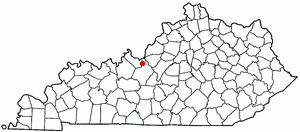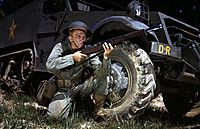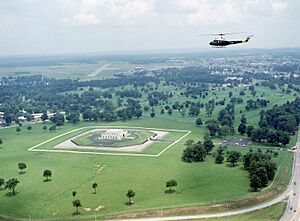Fort Knox facts for kids
Quick facts for kids Fort Knox |
|
|---|---|
| Kentucky | |
 |
|

Location of Fort Knox in Kentucky
|
|
| Coordinates | 37°55′N 85°58′W / 37.92°N 85.96°W |
| Type | Military base |
| Site information | |
| Controlled by |
|
| Site history | |
| Built | 1918 |
| In use |
|
| Garrison information | |
| Current commander |
COL Lance O'Bryan |
Fort Knox is a famous United States Army base in Kentucky. It is located south of Louisville and north of Elizabethtown. The base is huge, covering parts of three counties: Bullitt, Hardin, and Meade. It spans about 109,000 acres (441 square kilometers).
Fort Knox is well-known because it is right next to the United States Bullion Depository. This super-secure building holds a large part of the United States' official gold reserves. People often mix up the army base with the gold vault, but they are separate.
Today, Fort Knox is home to the Army Human Resources Center of Excellence. This includes the Army Human Resources Command, which manages soldiers' careers. The base is named after Henry Knox, who was the chief of artillery during the American Revolutionary War. He also became the first United States Secretary of War.
For 60 years, Fort Knox was the main training center for U.S. Army and Marine Corps tank crews. They learned to operate tanks like the M1 Abrams here. You can learn about the history of the U.S. Army's Cavalry and Armored forces at the General George Patton Museum of Leadership. This museum is located right on the Fort Knox base.
In 2011, the Army's Armor School moved from Fort Knox to Fort Moore, Georgia. However, in 2014, the U.S. Army Cadet Command moved to Fort Knox. Now, all summer training for ROTC cadets happens there. ROTC is a program that trains college students to become Army officers. In 2020, a military unit called V Corps was also brought back to life at Fort Knox.
Contents
The Famous Gold Vault: Bullion Depository
The United States Bullion Depository is often simply called "Fort Knox." It is a very strong, fortified vault building. This building is right next to the Fort Knox Army Post. The U.S. Department of the Treasury runs it.
The depository holds more than half of the country's gold reserves. It is protected by the United States Mint Police. The building is famous for its incredible physical security. It is one of the most secure places in the world.
The Treasury built the depository in 1936. The land for it was given by Fort Knox. Early shipments of gold, weighing almost 13,000 metric tons, were brought here. They were guarded by combat vehicles from the 1st U.S. Cavalry Regiment.
Besides gold, the depository has also protected other very important items. These include the original copies of the Constitution of the United States and the United States Declaration of Independence.
Fort Knox Community
Parts of the Fort Knox base are considered a special community. This community had a population of 12,377 people in 2000. By 2020, the population was 7,742.
General George Patton Museum
The General George Patton Museum of Leadership is located at Fort Knox. It has exhibits about military leadership. One exhibit focuses on leadership challenges after the attacks of September 11, 2001. This exhibit includes two firetrucks. One of them, called Foam 161, was partly burned and melted during the attack on the Pentagon.
Fort Knox is also home to the Timothy Maude Center of Excellence. This center is part of the U.S. Army's Human Resources Command. It is named after Lieutenant General Timothy Maude. He was the highest-ranking U.S. military member to die in the 9/11 attacks.
History of Fort Knox
Early Fortifications and the Civil War
In 1861, during the American Civil War, forts were built near the current site of Fort Knox. One of these was Fort Duffield. It was on a strategic hill called Muldraugh Hill. This spot overlooked where the Salt and Ohio Rivers met. It also watched over a main road.
Both the Union and Confederate armies fought over this area. Organized groups of guerrillas often raided the area during the war. John Hunt Morgan, a Confederate cavalry leader, raided the area. He then launched his famous raid into Indiana and Ohio.
After the Civil War
After the war, the land that is now Fort Knox was home to small towns. In 1903, the army held military exercises here. These included soldiers from the Regular Army and National Guards from several states. In 1918, field artillery units came to the area for training.
The government leased 20,000 acres (8,100 hectares) near a village called Stithton. Construction for a permanent training center began in July 1918.
Building the New Camp
The new camp was named Camp Knox. It honored Henry Knox, a hero of the American Revolutionary War. He was the first Secretary of War for the United States. The camp grew larger with the purchase of another 40,000 acres (16,000 hectares) in June 1918.
However, the building plans were cut back after World War I ended. The camp became a smaller training center. It was used for Reserve Officer training, the National Guard, and Citizen's Military Training Camps. For a few years, from 1925 to 1928, the area was even called "Camp Henry Knox National Forest."
Airfield Use at Fort Knox
Fort Knox has an airfield called Godman Army Airfield. The United States Army Air Corps and later the United States Army Air Forces used it. They trained pilots here during World War II. After the war, the Kentucky Air National Guard used it for several years. They later moved to Louisville. The airfield is still used by the United States Army Aviation Branch today.
Protecting America's Founding Documents
After the Japanese attack on Pearl Harbor in 1941, important U.S. documents needed protection. The Declaration of Independence, the Constitution of the United States, and the Gettysburg Address were all moved. They were kept safe at the United States Bullion Depository. They stayed there until September 19, 1944, after the D-Day Landings in Europe.
The Rise of Mechanized Military Units

In 1931, a small group of "mechanized" cavalry soldiers came to Camp Knox. Mechanized means they used vehicles like tanks instead of horses. They used the camp for training. In January 1932, the camp became a permanent army base and was renamed Fort Knox.
The 1st Cavalry Regiment arrived soon after. They became the 1st Cavalry Regiment (Mechanized). In 1936, they were joined by another regiment, forming the 7th Cavalry Brigade (Mechanized). Fort Knox quickly became the main place for developing new tank tactics.
The success of German tank units at the start of World War II made the U.S. realize how important tanks were. In July 1940, a new Armored Force was created, with its main office at Fort Knox. The 7th Cavalry Brigade became the 1st Armored Division. The Armored Force School and Replacement Center also opened at Fort Knox in October 1940. These schools stayed there until 2010.
The base grew a lot to handle its new role. By 1943, there were 3,820 buildings on 106,861 acres (43,249 hectares).
Army Human Resources Command
The Army Human Resources Command (HRC) moved to Fort Knox starting in 2009. It came from the Washington D.C./Virginia area. New buildings were constructed for it. One of these is the Army Human Resource Center. This is the largest construction project in Fort Knox's history. It is a huge complex of six connected buildings, covering 104 acres (42 hectares).
In May 2010, the Human Resource Center of Excellence opened. It is the largest office building in Kentucky. Nearly 4,300 soldiers and civilians work there.
Education at Fort Knox
The Department of Defense Education Activity (DoDEA) runs public schools on the base. These schools serve children living at Fort Knox. They include:
- Kingsolver Elementary School (Pre-Kindergarten-Grade 1)
- Van Voorhis Elementary School (Pre-Kindergarten-Grade 5)
- Scott Intermediate School (Grades 6–8)
- Fort Knox Middle High School (Grades 9–12)
The high school was built in 1958. It has been updated a few times, including a new building completed in 2007.
Units and Tenants at Fort Knox
Current Units
Many important military units are currently based at Fort Knox:
 V Corps
V Corps United States Army Recruiting Command (This is the senior commander at Fort Knox)
United States Army Recruiting Command (This is the senior commander at Fort Knox)
 United States Army Cadet Command
United States Army Cadet Command United States Army Human Resources Command
United States Army Human Resources Command First Army Division East
First Army Division East
 1st Sustainment Command (Theater)
1st Sustainment Command (Theater) 84th Training Command
84th Training Command 100th Training Division (Leader Development)
100th Training Division (Leader Development)
 U.S. Army Garrison Fort Knox
U.S. Army Garrison Fort Knox Army Reserve Aviation Command
Army Reserve Aviation Command Army Reserve Careers Group
Army Reserve Careers Group Ireland Army Health Clinic
Ireland Army Health Clinic 19th Engineer Battalion
19th Engineer Battalion 34th Military Police Detachment
34th Military Police Detachment 905th Military Police Detachment
905th Military Police Detachment 100th Army Band
100th Army Band
Previous Units
Some units that used to be at Fort Knox include:
 3rd Sustainment Command (Expeditionary) (moved in 2015)
3rd Sustainment Command (Expeditionary) (moved in 2015) 1st Armor Training Brigade (no longer active since 2010)
1st Armor Training Brigade (no longer active since 2010) 3rd Brigade, 1st Infantry Division (no longer active since 2014)
3rd Brigade, 1st Infantry Division (no longer active since 2014) 16th Cavalry Regiment (no longer active since 2010)
16th Cavalry Regiment (no longer active since 2010) 316th Cavalry Brigade (moved in 2011)
316th Cavalry Brigade (moved in 2011) 194th Armored Brigade (moved in 2011)
194th Armored Brigade (moved in 2011) 477th Bombardment Group (moved in 1946)
477th Bombardment Group (moved in 1946) 46th Adjutant General Battalion (Reception) (no longer active since 2011)
46th Adjutant General Battalion (Reception) (no longer active since 2011) 113th Army Band (no longer active since 2016)
113th Army Band (no longer active since 2016)
Geography and Climate
Fort Knox is located along the Ohio River. The gold depository is also nearby. The base covers about 20.94 square miles (54.2 square kilometers). Most of this area is land, with a small amount of water.
Towns near Fort Knox include Brandenburg, Elizabethtown, Hodgenville, Louisville, Radcliff, Shepherdsville, and Vine Grove. The city of Muldraugh in Meade County is completely surrounded by Fort Knox.
The climate at Fort Knox has hot, humid summers. Winters are generally mild to cool. This type of weather is called a humid subtropical climate.
People of Fort Knox
In 2000, there were 12,377 people living on the Fort Knox base. Most of the people living there were White (66.3%) or African American (23.1%). About 10.4% of the population were Hispanic or Latino.
Many households had children under 18 living with them (77.7%). Most families were married couples living together (86.0%). The average household had about 3.49 people.
The median age of people on the base was 22 years old. This is common for military bases, as many young soldiers and their families live there. For every 100 females, there were about 155.7 males. This also shows the large number of male soldiers.
The median income for a household on the base was about $34,020 per year. These numbers are typical for military communities.
See also
 In Spanish: Fort Knox para niños
In Spanish: Fort Knox para niños


